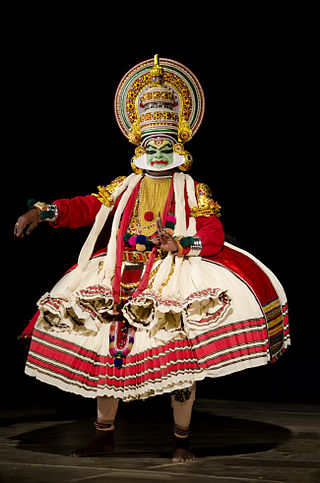Related Research Articles
Guru Kunju Kurup (1881–1970) was a Kathakali dancer from south Kerala, India.
Kavalappara Narayanan Nair (1882–1948) was a prominent 20th-century Kathakali artiste and tutor who specialised in the Hanuman roles of the classical dance-drama from Kerala in south India.

C. N. Karunakaran was an Indian painter, illustrator and art director from Kerala. He was the Chairman of the Kerala Lalitakala Academy and a recipient of several honours including the Kerala Lalithakala Akademi Award which he won thrice. The Akademi honoured him again with the fellowship in 2005.

Kottakkal Sivaraman was a performing artiste who revolutionised the portrayal of female roles in Kathakali, the classical dance-drama from Kerala in southern India.

Vadakke Manalath Govindan Nair popularly known as Kalamandalam Gopi, is an Indian dancer who is an exponent of the classical dance-drama style known as Kathakali.
Kalamandalam Krishnan Nair was a Kathakali dancer from Kerala in India.
Chandramana Govindan Namboothiri was a famous Kathakali artist from the South Indian state of Kerala
Gandhi Seva Sadan is a Kathakali institution located in Perur village, some 12 kilometres east of Ottapalam in Palakkad district of north-central Kerala in southern India. It was founded in 1953 by the (late) Gandhian and freedom fighter K. Kumaran, equally known for his unflagging devotion to the promotion of the arts.
Keezhpadam Kumaran Nair (1916–2007) was a Kathakali artists from Kerala, India. Endowed and equip with a life profile that also show him to several traditional Indian performing arts other than Kathakali, his stage presentation infused a fresh breath into the four-century-old art form, thanks also to his broad and deep view about the Puranas that spurred from a constant pursuit of knowledge through reading books and engaging in talks in scholars.
Kalamandalam Sankaran Embranthiri (1944–2007) was one of the most popular Kathakali musicians, credited with initiating a new wave in the rendition of songs for the classical dance-drama from Kerala in south India. His shruti-aligned music was glistened by a velvety voice, easy reach of the three octaves and command over stage proceedings that won him massive fan following even as his form received an abrupt setback in 1990 when he suffered a major ailment from which he could never recover fully.

Pattikkamthodi Ravunni Menon (1880-1948) was a pivotal figure in the history of Kathakali, having played a crucial role in remoulding and refining its grammar in the famed Kalluvazhi tradition of the classical dance-drama from Kerala in south India. He was trained in the art form at a culture-patronising Namboodiri mansion in Vellinezhi near his home.
Vazhenkada Kunchu Nair, also spelt Kunju Nair, (1909-1981) was an Indian Kathakali dancer.

Kalamandalam Vasu Pisharody was an Indian Kathakali actor known for his classical dance-drama of Kerala. A frontline disciple of Padma Shri Vazhenkada Kunchu Nair, he exceled in virtuous pachcha, anti-hero Kathi and the semi-realistic minukku roles alike. Nalan, Bahukan, Arjunan, Bhiman, Dharmaputrar, Rugmangadan, Narakaasuran, Ravanan, Parashuraman and Brahmanan were his masterpieces. Vasu Pisharody performed Kathakali all over India and visited foreign countries about 20 times.

Kavungal Chathunni Panicker (1922-2007) was an Indian classical dancer, known for his proficiency in Kathakali, the traditional dance form of Kerala. He was an exponent of the Kavungal School of Kathakali, noted for its rigorous training methods and overt physical interpretation of abhinaya. He is known to have brought innovations to the dance form, especially in the decorative movements (kalasam) and his contributions are reported in the development of grammar and costumes for the Kavungal School. A recipient of the Sangeet Natak Akademi Award in 1973, Panicker was honored again by the Government of India, in 2006, with the fourth highest Indian civilian award of Padma Shri.
Mathoor Govindan Kutty was an Indian Kathakali artist from the state of Kerala. In a career spanning over six decades, he specialized in Kathakali Stri Vesham, the portrayal of female characters on stage. He was the recipient of the 2011 Kerala State Award for the best Kathakali artist, 2010 Kerala Sangeetha Nataka Akademi Award and the 2005 Sangeet Natak Akademi Award for contributions to the Kathakali art form.
Kalamandalam Kuttan Asan was an Indian Kathakali artiste from Kerala. He was known as Dakshan Kuttan as he was popular in the role of Daksha. He received awards including the Sangeet Natak Akademi Award 2008 and Kerala State Kathakali Award 2019.

Kalamandalam Ramachandran Unnithan is a Kathakali exponent from Kerala, India. He received several awards including the Sangeet Natak Akademi Award 2016. His biography titled Kachaiyum Mizhukkum was published in 2015.
Tonnakkal Peethambaran is a Kathakali exponent from Kerala, India. He has been honored with several noted awards including the Kerala Sangeetha Nataka Akademi Award 2003, Sangeet Natak Akademi Award 2011 and Kerala State Kathakali Award 2014.
Kalamandalam Rajan is a Kathakali exponent from Kerala, India. He has been honored with several noted awards including the Sangeet Natak Akademi Award 2009, Kerala Sangeetha Nataka Akademi Gurupooja award 2006 and awards from Kerala Kalamandalam.
Varanasi Vishnu Namboothiri is a Maddalam exponent from Kerala, India, best known for playing Maddalam for Kathakali performances. He received several noted awards including Sangeet Natak Akademi Award, Kerala Sangeetha Nataka Akademi Gurupooja Award and Kerala Kalamandalam Award.
References
- ↑ Kathakali Vijnankosam (Kathakali Encyclopedia, page 314)
https://web.archive.org/web/20150527122916/http://satsangam.org/maryse.html